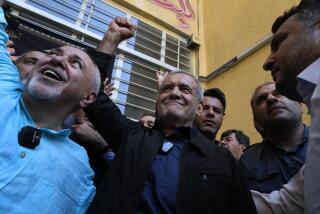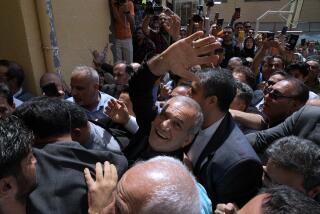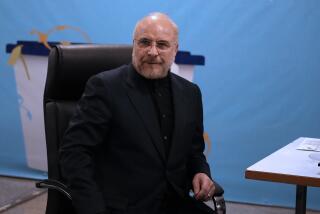Tensions Remain High : In Iran, U.S. Is Still the ‘Great Satan’
- Share via
TEHRAN — At the Grand Fajr Hotel in Ahvaz, a city about 350 miles southwest of here, an American flag is painted where the doormat should be.
No public ceremony is complete in Iran without at least a few shouted choruses of “Death to the U.S.A.,” a slogan displayed in every airport and hotel lounge.
Even at the front in the war against Iraq, where there are daily bombardments by Soviet-supplied planes and artillery, the Iranian troops get worked up by chanting, “Down With America!”
Iran’s revolution was seven years old in February, but relations between Tehran and Washington are still at the same frosty level that existed the day President Reagan took office and the American hostages were released from the U.S. Embassy in Tehran after being held for 444 days.
Tensions Still High
There is no sign of any relaxation of tension, as some have suggested has taken place recently between Iran and the Soviet Union, which were also estranged at the time of the revolution.
Some analysts believe that relations with the United States will never improve as long as the Ayatollah Ruhollah Khomeini, Iran’s spiritual leader, is alive. He is at least 84 years old.
“It will be very difficult to repair relations with the United States,” a Western diplomat observed. “After all, the United States was declared the “Great Satan” by Khomeini, and to a certain extent the Iranians need to have a big, external enemy for propaganda purposes.”
The Speaker of the Iranian Parliament, Hashemi Rafsanjani, indicated on a trip to Japan last year that Iran was considering an improvement in relations with the United States, but he said the initiative would have to come from Washington, according to diplomatic sources here.
Iran Wants Apology
Among the conditions Iran has imposed for such an improvement is that the United States formally apologize to Iran for the assistance it extended to the government of Shah Mohammed Reza Pahlevi. The United States has taken the position that it has nothing to apologize for in its relations with Iran.
There have been occasional gestures from one side to the other, but according to diplomats here, the moves have been neither significant nor long-lasting. For example, in January, Iran made a conciliatory gesture by paying Chevron, the American oil firm, $115 million to settle claims arising out of the revolution.
Diplomatic analysts said the payment, from a fund established in The Hague as part of the agreement that ended the hostage crisis, cleared the way for settling more than $1 billion in claims made by other American firms.
Conciliatory Gesture
In February, the Reagan Administration appeared to be making a conciliatory gesture when it condemned Iraq for using chemical weapons against Iranian troops. Washington had taken similar action before, but it was based on a lengthy investigation by the United Nations. This time the Administration acted on its own, on the basis of evidence it said was gathered independently.
Nonetheless, the conviction still exists in Iran that the United States has tilted toward the Baghdad regime in the 5 1/2-year war and that it has even provided intelligence to the Iraqis.
The Iranians have been severely hampered in the conduct of the war by their inability to buy spare parts for the huge inventory of American-made weapons that had been provided to the shah before the revolution. Since 1979, when the shah was toppled, the United States has imposed a total arms embargo.
Although Tehran has officially banned trade with the United States in retaliation for the American embargo on Iran, American goods still turn up in shops in the Iranian capital. No precise figures are kept, but diplomats estimate the two-way trade with the United States at any where from $100 million to $2 billion a year.
Principally, the Iranians are importing spare parts from the United States, often disguised by or passed through middlemen in Europe. The United States largely buys Iranian crude oil on the spot market, where it is not traceable.
Ironically, Americans as individuals are highly popular among Iranians, who frequently say they hope to visit the United States.
There are an estimated 2 million Iranians living in the United States, of whom 110,000 to 300,000, depending on the source of the calculation, live in Southern California. Many of the Iranian expatriates regard themselves as exiles from the Khomeini regime, but the ayatollah also purportedly enjoys considerable support among Iranians in the United States.
In contrast to its relations with the United States, Iran has recently demonstrated a willingness to improve its ties with the Soviets, who were also considered a Great Satan at the time of the revolution. A symbolic improvement came last fall when Revolutionary Guards washed anti-Soviet slogans off the walls of the Soviet embassy in Tehran.
More important was a visit here in January by Soviet First Deputy Foreign Minister Georgy M. Kornienko. Among other things, the Iranians and Soviets agreed to revive a joint commission on trade, although no meetings have taken place.
“The Iranians are trying to engage the Soviets in some sort of dialogue in an effort to offset the close relations between the Soviets and the Iraqis,” a Western diplomat said.
Also, because the Iranians import their heating oil and kerosene from the Soviet Union, they cannot afford to let relations get too chilly.
But it is still not clear whether the effort at reconciliation is taking root. After all, most of the leaders of Tudeh, Iran’s Moscow-leaning Communist Party, are still in prison.
Perhaps even more telling--after the Iranians opened their latest offensive in the war against Iraq--a Soviet commentator, Alexander Bovin, said the Iranian position was “unconstructive and irrational.”
More to Read
Sign up for Essential California
The most important California stories and recommendations in your inbox every morning.
You may occasionally receive promotional content from the Los Angeles Times.










